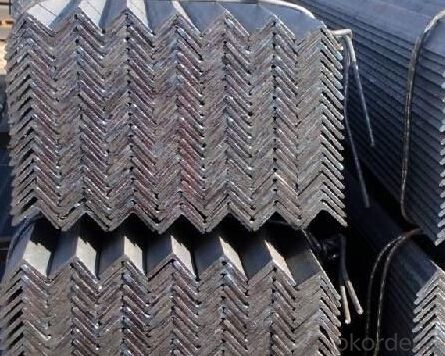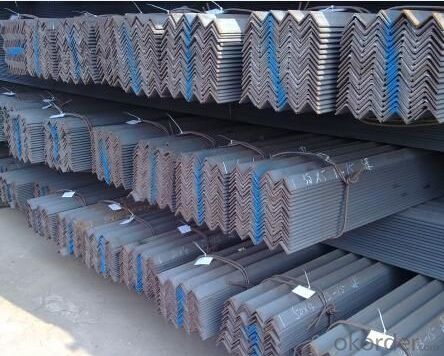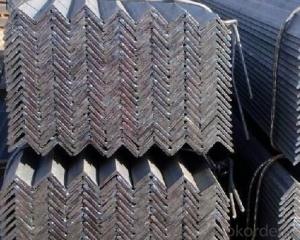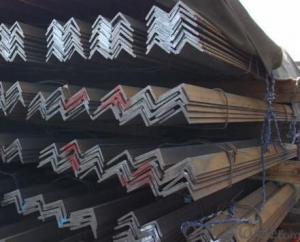Angle Steel with Material: GB Q235B, Q345B
- Loading Port:
- China main port
- Payment Terms:
- TT or LC
- Min Order Qty:
- 100 m.t.
- Supply Capability:
- 5000 m.t./month
OKorder Service Pledge
OKorder Financial Service
You Might Also Like
Product Description:
OKorder is offering Angle Steel with Material: GB Q235B, Q345B at great prices with worldwide shipping. Our supplier is a world-class manufacturer of steel, with our products utilized the world over. OKorder annually supplies products to European, North American and Asian markets. We provide quotations within 24 hours of receiving an inquiry and guarantee competitive prices.
Product Applications:
Angle Steel with Material: GB Q235B, Q345B are ideal for structural applications and are widely used in the construction of buildings and bridges, and the manufacturing, petrochemical, and transportation industries.
Product Advantages:
OKorder's Angle Steel with Material: GB Q235B, Q345B are durable, strong, and resist corrosion.
Main Product Features:
· Premium quality
· Prompt delivery & seaworthy packing (30 days after receiving deposit)
· Corrosion resistance
· Can be recycled and reused
· Mill test certification
· Professional Service
· Competitive pricing
Product Specifications:
1. Standards: GB,ASTM,BS,AISI,DIN,JIS
2. Invoicing on theoretical weight or actual weight as customer request
3. Material:Material: GB Q235B, Q345B or Equivalent; ASTM A36; EN 10025, S235JR, S355JR; JIS G3192, SS400; SS540.
4. Sizes:
Sizes: 25mm-250mm | ||
a*t | ||
25*2.5-4.0 | 70*6.0-9.0 | 130*9.0-15 |
30*2.5-6.6 | 75*6.0-9.0 | 140*10-14 |
36*3.0-5.0 | 80*5.0-10 | 150*10-20 |
38*2.3-6.0 | 90*7.0-10 | 160*10-16 |
40*3.0-5.0 | 100*6.0-12 | 175*12-15 |
45*4.0-6.0 | 110*8.0-10 | 180*12-18 |
50*4.0-6.0 | 120*6.0-15 | 200*14-25 |
60*4.0-8.0 | 125*8.0-14 | 250*25 |
5. Material details:
Alloy No | Grade | Element (%) | |||||
C | Mn | S | P | Si | |||
|
|
|
|
|
|
| |
Q235 | B | 0.12—0.20 | 0.3—0.7 | ≤0.045 | ≤0.045 | ≤0.3 | |
|
|
|
|
|
|
| |
Alloy No | Grade | Yielding strength point( Mpa) | |||||
Thickness (mm) | |||||||
≤16 | >16--40 | >40--60 | >60--100 | ||||
≥ | |||||||
|
|
|
|
|
| ||
Q235 | B | 235 | 225 | 215 | 205 | ||
Alloy No | Grade | Tensile strength (Mpa) | Elongation after fracture (%) | ||||
Thickness (mm) | |||||||
| ≤16 | >16--40 | >40--60 | >60--100 | |||
≥ | |||||||
|
|
|
|
|
|
| |
Q235 | B | 375--500 | 26 | 25 | 24 | 23 | |
Usage & Applications of GB Q235 Angle Steel
Trusses;
Transmission towers;
Telecommunication towers;
Bracing for general structures;
Stiffeners in structural use.
Packaging & Delivery of GB Q235 Angle Steel
1. Transportation: the goods are delivered by truck from mill to loading port, the maximum quantity can be loaded is around 40MTs by each truck. If the order quantity cannot reach the full truck loaded, the transportation cost per ton will be little higher than full load.
2. With bundles and load in 20 feet/40 feet container, or by bulk cargo, also we could do as customer's request.
3. Marks:
Color mark: There will be color marking on both end of the bundle for the cargo delivered by bulk vessel. That makes it easily to distinguish at the destination port.
Tag mark: There will be tag mark tied up on the bundles. The information usually including supplier logo and name, product name, made in China, shipping marks and other information request by the customer.
If loading by container the marking is not needed, but we will prepare it as customer request.
FAQ:
Q1: Why buy Materials & Equipment from OKorder.com?
A1: All products offered byOKorder.com are carefully selected from China's most reliable manufacturing enterprises. Through its ISO certifications, OKorder.com adheres to the highest standards and a commitment to supply chain safety and customer satisfaction.
Q2: How do we guarantee the quality of our products?
A2: We have established an advanced quality management system which conducts strict quality tests at every step, from raw materials to the final product. At the same time, we provide extensive follow-up service assurances as required.
Q3: How soon can we receive the product after purchase?
A3: Within three days of placing an order, we will begin production. The specific shipping date is dependent upon international and government factors, but is typically 7 to 10 workdays.
A4: Stainless steel must contain at least 10.5 % chromium. It is this element that reacts with the oxygen in the air to form a complex chrome-oxide surface layer that is invisible but strong enough to prevent further oxygen from "staining" (rusting) the surface. Higher levels of chromium and the addition of other alloying elements such as nickel and molybdenum enhance this surface layer and improve the corrosion resistance of the stainless material.
Q5: Can stainless steel rust?
A5: Stainless does not "rust" as you think of regular steel rusting with a red oxide on the surface that flakes off. If you see red rust it is probably due to some iron particles that have contaminated the surface of the stainless steel and it is these iron particles that are rusting. Look at the source of the rusting and see if you can remove it from the surface.
Images:


"The angle is perpendicular to each other on both sides of the steel strip into the corner. There are equilateral angle steel and unequal angle points. An equal angle two edge width equal.
The angle is built with carbon steel, is a simple section steel steel, mainly used for metal components and the frame of the plant. In the use of the requirements are good, plastic deformation properties and a certain mechanical strength. The production of raw materials for low carbon steel billet steel billets, finished angle for the hot rolling, normalizing or hot-rolled state of delivery.
The specifications are expressed by the MM number of edges and sides and the thickness of the thick. Such as ""/ 30 x 30 x 3"", that is 30 mm equilateral angle edge width edge thickness was 3 mm. Also available models that model is the number of centimeters wide, such as angle 3#. Model doesn't mean thickness angle of different size in the same model, thus in the edge of the contracts and other documents will be angle width, edge thick size fill in complete, avoid separate model, said. The specifications for 2#-20# hot rolled equilateral angle steel.
The surface quality of the equilateral angle steel are specified in the standard and may not generally require the use of harmful defects, such as delamination, scarring, and cracks. Equilateral angle geometry error allowed range in the standard also provides, in general, including bending, edge width, edge thickness, dip angle and theoretical weight, and provides significant torsional angle not.
Angle according to the different needs of structure composed of a variety of stress components, can also be used as a component of the connections between the. Angle steel is mainly used for manufacturing the frame structure, such as high voltage transmission tower, steel structure bridge girder on both sides of the framework, tower crane of the column and arm lever on the construction site, workshop of column and beam, small place such as festivals roadside put pot in the shape of a shelf, in window hanging solar air conditioning such as shelves.
"
- Q:Can steel angles be drilled?
- Yes, steel angles can be drilled.
- Q:How do you store steel angles?
- Steel angles can be stored by stacking them horizontally on a flat and stable surface, ensuring that they are separated by wooden blocks or dunnage to prevent any damage or deformation. It is advisable to keep them in a dry and well-ventilated area to prevent rust or corrosion. Additionally, storing them indoors or under a weatherproof covering can provide further protection against environmental elements.
- Q:Can steel angles be used in electrical grounding applications?
- Yes, steel angles can be used in electrical grounding applications. Steel angles are commonly used in construction for their strength and durability. In electrical grounding applications, steel angles can be used to create grounding grids or grounding systems. These grids or systems help to prevent electrical shock hazards by providing a low-resistance path for electrical currents to flow to the ground. Steel angles are often used as structural components in these grounding systems due to their ability to withstand physical stress and their conductive properties. However, it is important to ensure that the steel angles are properly installed and connected to the electrical system in accordance with relevant codes and standards to ensure effective grounding and safety.
- Q:How do you determine the appropriate length of a steel angle for a specific application?
- Determining the appropriate length of a steel angle for a specific application involves considering several factors. Firstly, you need to assess the structural requirements of the application. This includes analyzing the loads and forces that the steel angle will be subjected to. You should determine the maximum load capacity the steel angle needs to support and ensure that its length can adequately distribute the load without excessive deflection or failure. Secondly, you should consider the dimensions and layout of the application. Measure the available space and determine how the steel angle will fit within the overall structure. Consider any constraints such as adjacent components or obstructions that might affect the length of the steel angle. Next, you should consult relevant engineering and construction standards. Codes and guidelines provide recommended design values and specifications for steel angles based on their intended use. These standards can help you determine the appropriate length based on the application requirements and the material properties of the steel angle. Additionally, it is important to consider the fabrication and installation process. Evaluate the manufacturing capabilities and limitations, as well as any specific requirements for joining or fastening the steel angle. This will help determine if the desired length is feasible and practical in terms of fabrication and installation methods. Finally, it is advisable to consult with a structural engineer or a qualified professional in the field. They can provide expert advice and calculations based on the specific application, ensuring that the chosen length of the steel angle meets all necessary safety and performance requirements. In conclusion, determining the appropriate length of a steel angle for a specific application involves analyzing the structural requirements, considering the dimensions and layout, referring to relevant standards, evaluating fabrication and installation processes, and seeking professional guidance when needed.
- Q:What are the different methods for strengthening steel angles?
- There are several methods for strengthening steel angles, including heat treatment, cold working, and alloying. Heat treatment involves heating the steel to a specific temperature and then cooling it rapidly to increase its hardness and strength. Cold working, on the other hand, involves deforming the steel at room temperature to enhance its strength. Alloying is another method where additional elements are added to the steel to improve its strength and other properties.
- Q:What are the different corrosion protection methods for steel angles?
- There are several corrosion protection methods for steel angles, including galvanization, powder coating, paint coating, and epoxy coating.
- Q:Can steel angles be used in railway track construction?
- Yes, steel angles can be used in railway track construction. Steel angles are often used as a structural component in the construction of railway tracks. They provide strength and stability to the track system, helping to support the weight of the train and distribute the load evenly. Steel angles are commonly used for the construction of rail joints, which connect two sections of rail together, as well as for the installation of rail fastenings and track accessories. They are durable, resistant to wear, and can withstand heavy loads and high impact forces, making them an ideal choice for railway track construction.
- Q:Are steel angles suitable for coastal or saltwater environments?
- Steel angles can indeed be used in coastal or saltwater environments, but it is essential to consider the steel type and implement proper protection measures for durability and resistance against corrosion. Stainless steel angles, especially those made from marine grade stainless steel like 316 or 316L, are highly regarded for their outstanding resistance to corrosion in saltwater environments. These angles contain higher levels of chromium and molybdenum, which offer superior protection against rust and corrosion caused by exposure to saltwater and other harsh elements. Moreover, additional protective coatings or treatments such as galvanization or epoxy coating can be applied to steel angles to further enhance their resistance to corrosion in coastal or saltwater settings. These coatings establish a barrier between the steel and the corrosive elements, preventing direct contact and reducing the risk of rust or corrosion. To determine the most appropriate steel type and protective measures for a specific project in coastal or saltwater areas, it is crucial to consult with structural engineers, architects, or steel suppliers who specialize in such applications. Regular maintenance and inspections play a vital role in promptly identifying any signs of corrosion or damage and addressing them to ensure the longevity and safety of steel angles in coastal or saltwater environments.
- Q:What are the different types of steel angles used in fencing and gates?
- There are several different types of steel angles that are commonly used in fencing and gates. One of the most common types is the equal angle, also known as L-shaped angle. This type of angle has equal length sides and is commonly used for vertical and horizontal bracing in fencing and gates. Another type is the unequal angle, which has one longer side and one shorter side. This type of angle is often used for diagonal bracing in fencing and gates, as it provides additional strength and stability. There is also the rounded edge angle, which has rounded edges instead of sharp corners. This type of angle is often used in fencing and gates to reduce the risk of injury, as the rounded edges are less likely to cause cuts or other accidents. Additionally, there are slotted angles, which have pre-drilled holes along the length of the angle. These holes allow for easy attachment of fencing and gate components, such as panels or hinges. Finally, there are galvanized angles, which have been coated with a layer of zinc to protect against rust and corrosion. This type of angle is ideal for outdoor fencing and gates, as it provides long-lasting durability and resistance to the elements. Overall, the different types of steel angles used in fencing and gates offer various benefits in terms of strength, stability, safety, ease of installation, and resistance to rust and corrosion. The specific type of angle used will depend on the specific requirements and preferences of the fencing or gate project.
- Q:Can steel angles be used for staircases or handrails?
- Yes, steel angles can be used for staircases and handrails. Steel angles are versatile and commonly used in construction for their strength and durability. In staircases, steel angles can be used as stringers, providing support for the steps and ensuring stability. They can also be used as handrails, offering a sturdy grip and support for individuals using the staircase. Steel angles can be welded or bolted into place, making them an excellent choice for staircases and handrails that require secure and long-lasting installations. Additionally, steel angles can be customized to fit specific design requirements, allowing for flexibility in creating aesthetically pleasing and functional staircases and handrails.
1. Manufacturer Overview |
|
|---|---|
| Location | |
| Year Established | |
| Annual Output Value | |
| Main Markets | |
| Company Certifications | |
2. Manufacturer Certificates |
|
|---|---|
| a) Certification Name | |
| Range | |
| Reference | |
| Validity Period | |
3. Manufacturer Capability |
|
|---|---|
| a)Trade Capacity | |
| Nearest Port | |
| Export Percentage | |
| No.of Employees in Trade Department | |
| Language Spoken: | |
| b)Factory Information | |
| Factory Size: | |
| No. of Production Lines | |
| Contract Manufacturing | |
| Product Price Range | |
Send your message to us
Angle Steel with Material: GB Q235B, Q345B
- Loading Port:
- China main port
- Payment Terms:
- TT or LC
- Min Order Qty:
- 100 m.t.
- Supply Capability:
- 5000 m.t./month
OKorder Service Pledge
OKorder Financial Service
Similar products
New products
Hot products
Related keywords



























